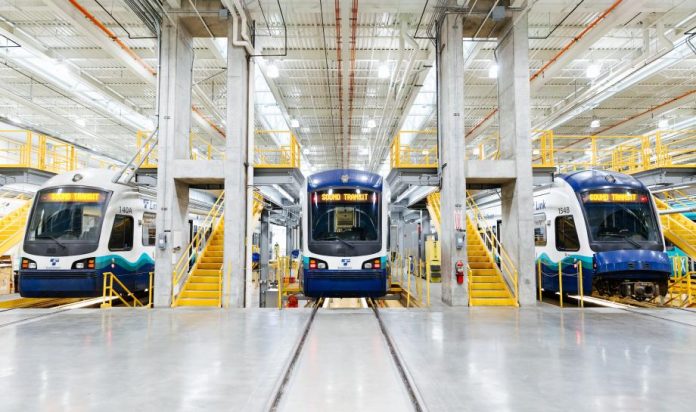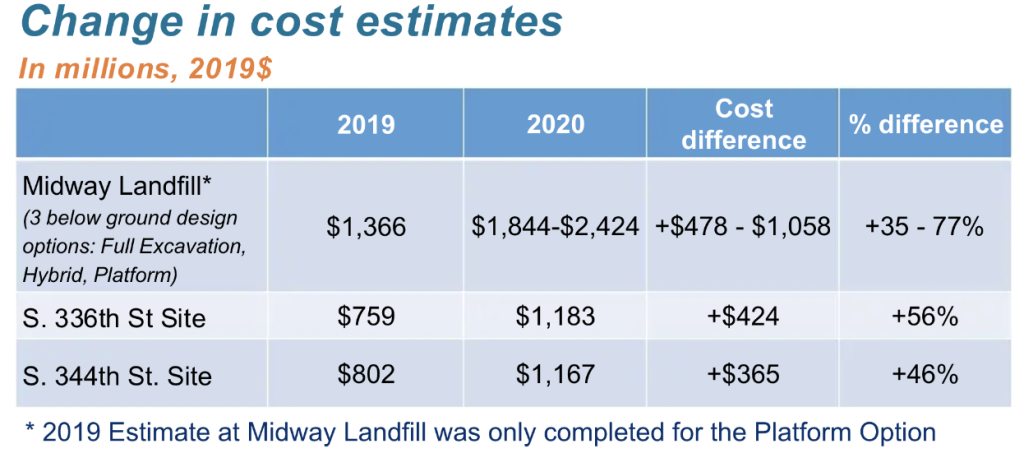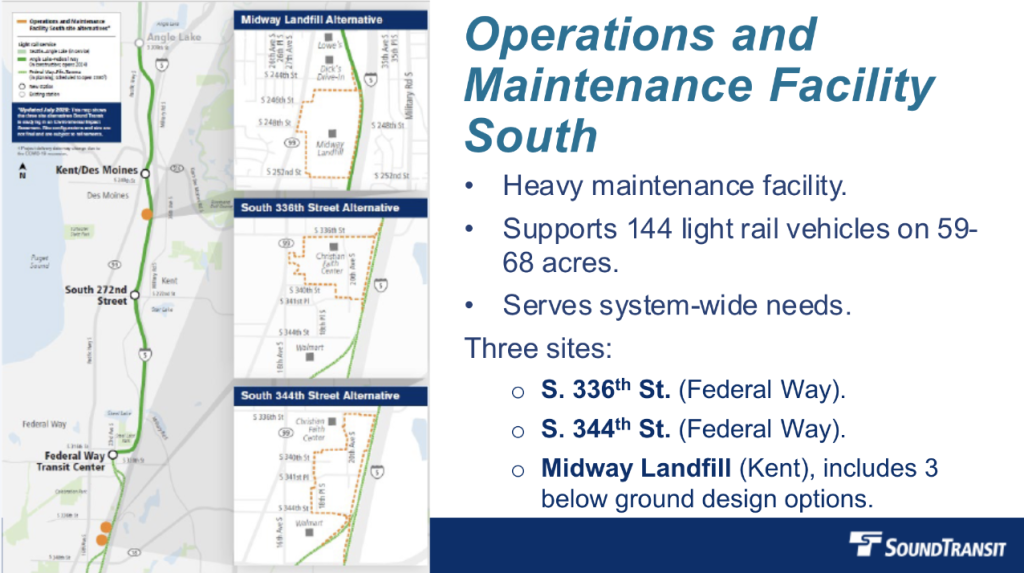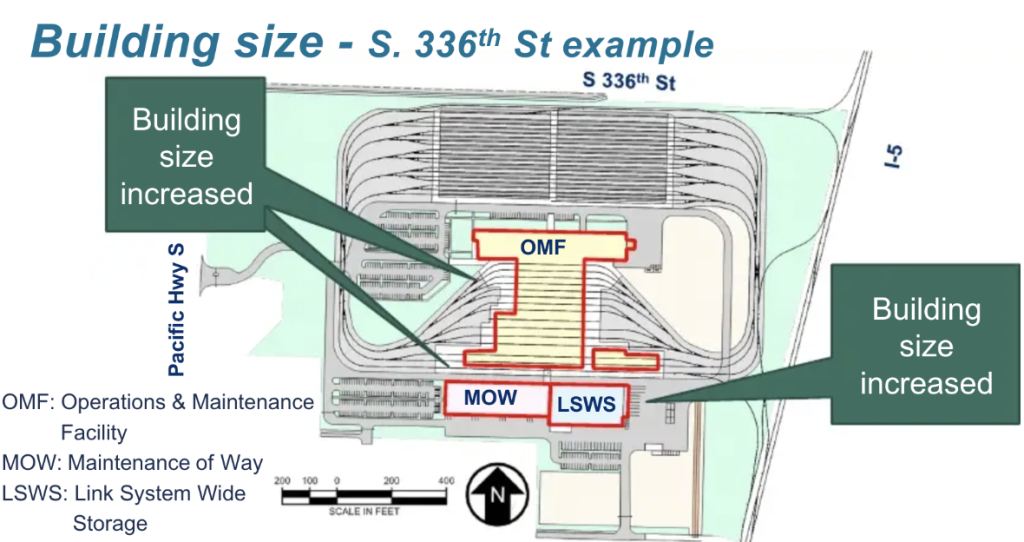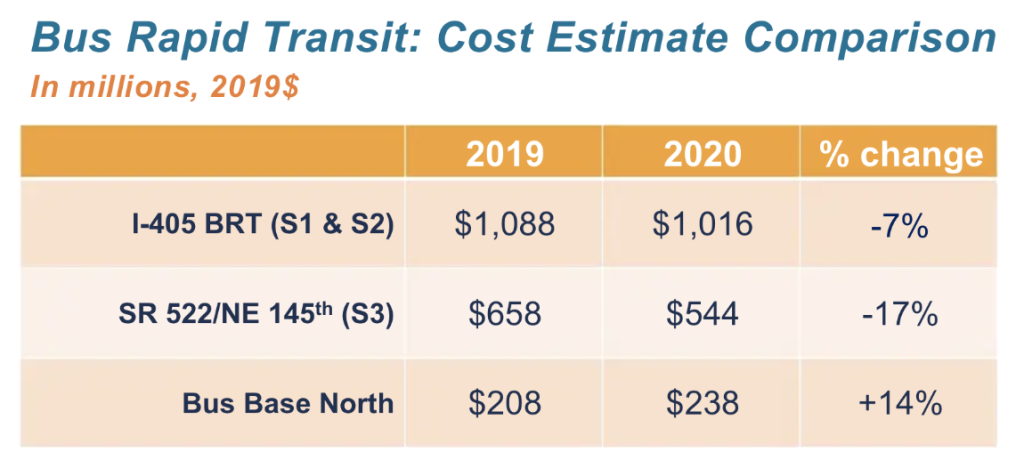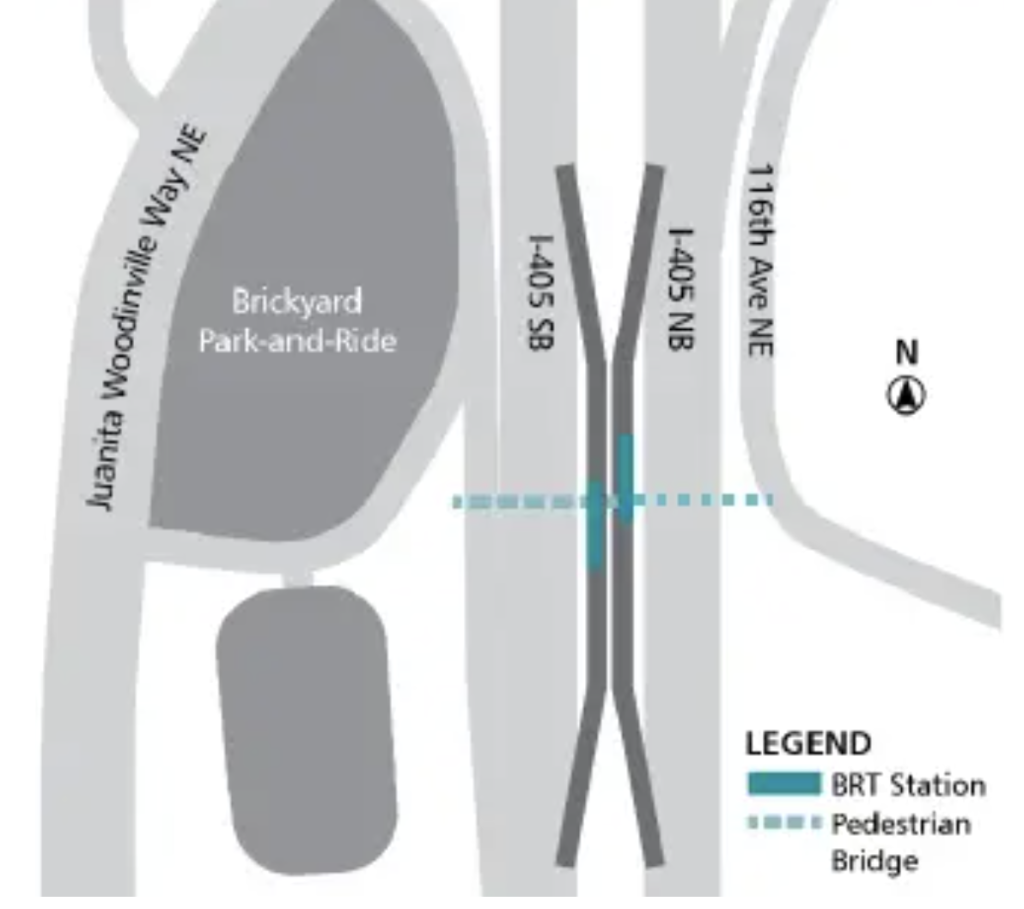Project cost increases are hitting most of the Sound Transit capital expansion portfolio with few exceptions. Agency staff briefed boardmembers last week with deeper details on project cost escalations for the Operations and Maintenance Facility South (OMFS) and the North Bus Base, with the most wild increases coming from the OMFS up to 77% over 2019 estimates. The new OMFS will support the southern Link light rail extension to Tacoma from central Federal Way while the North Bus Base will provide needed storage and maintenance facilities to support the planned Stride bus rapid transit lines. Agency staff also presented detailed cost estimate changes for the three Stride bus rapid transit projects.
OMFS project costs rise with Federal Way sites looking least expensive
It is worth cautioning that the most extreme cost increase applies to the Midway Landfill site for the OMFS. That same site could also see the lowest cost increase of the three sites currently under consideration for the OMFS. Cost estimates for the Midway Landfill site now stand between $1.84 billion $2.42 billion, which is a 35% to 77% increase over the 2019 estimate of $1.36 billion. New cost estimates for the S 336th St and S 344th St site have risen past the $1 billion mark, but are still more than $600 million cheaper than the least expensive Midway Landfill site option.
Agency staff indicated several reasons for the cost escalations. Construction and scope changes were a big driver. The need for larger buildings, more trackage, utilities, environmental mitigation, and soil challenges at the landfill site meant that estimates rose $224 million to $607 million in that category. Right-of-way acquisition costs increased about $46 million or even went down $27 million. And, project contingencies and soft costs (e.g., planning, design, and permitting) went up $155 million to $407 million.
In 2019, less than 5% of engineering work had been conducted on the OMFS. Agency staff used a common track layout to test-fit sites and applied similar cost assumptions for the 24 locations being analyzed. Engineering progressed to 10% design last year when that site alternatives were whittled down to three and deeper analysis was completed. That involved looking closer to building space assumptions and profiles, geotechnical results of soils, and increased project scope given that the OMFS will require space for about 470 employees instead of the original assumption of about 300. Examples of specific scope increases are a new central parts storage facility and more track space for vehicles.
Agency staff broke down the cost increases into finer detail.
The new assumed building size requirements sent costs upward $58 million as extra space for cleaning bays, training facilities, shop areas, and other spaces were added.
Stormwater management systems also ballooned–a common theme among operations and maintenance facilities for the agency–by $83 million to $110 million as the agency revised the scope, moving away from public stormwater system reliance to on-site systems. For space efficiency, the agency is increasingly looking at below-ground vaults for water storage instead of lower cost open detention ponds.
Trackage costs rose between $15 million and $36 million to meet the newly assumed maintenance and storage requirements for vehicles as well as longer tracks and additional switches for operational efficiency.
For the Midway Landfill site specifically, site preparation costs shot up between $82 million and $398 million because of the deeply unstable soils. Three options for site preparation are under consideration, which could include driving hundreds of deep shafts up to 180 feet underground to support a concrete platform where buildings and tracks could be placed on top of, excavation of the landfill followed by backfill of more stable soils, or a hybrid combination of those solutions. Landfill debris is very uneven and not fully compact to provide the necessary stability needed for the OMFS.
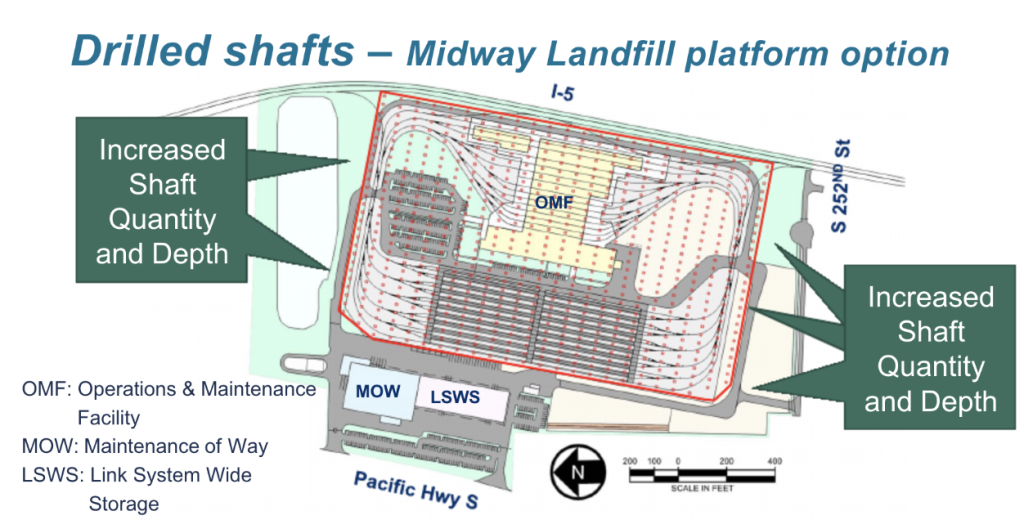
Conversely, the Federal Way sites saw environmental mitigation costs increase $52 million to $66 million as both have significant environmentally critical features on-site like wetlands and streams.
Given the cost considerations and differing complexity of a project at the three sites, it is abundantly evident that one of the Federal Way sites should be the obvious choice for Sound Transit. Further cost escalation could well occur in the following years. Dealing with the site preparation challenges of the Midway Landfill are not likely to get easier or cheaper, making it an expensive fool’s errand despite potential upsides that it would be more centrally located on the southern light rail corridor than the other two alternative locations and is a unique opportunity for remediation of a Superfund site and reuse; it would be an otherwise difficult site to develop for other public uses and more intensive uses like housing and commercial development.
Right now, the agency is finalizing the Draft Environmental Impact Statement for publishing on March 5th, a procedural hurdle under both the National Environmental Policy Act and State Environmental Policy Act for a project of this scope. A 45-day comment period will follow publication and boardmembers will have an opportunity to identify a preferred alternative in the summer or fall for final analysis in the Final Environmental Impact Statement. In the meantime, comments on OMFS planning can be emailed to omfsouth@soundtransit.org.
Cost decreases for Stride driven by WSDOT partnerships and scope reductions
Turning to Stride, agency staff highlighted cost estimate refinements for all three planned lines (S1, S2, and S3) as well as the new Bus Base North.
Costs for the S1 and S2 Lines on I-405 went down $72 million to $1.01 billion while cots for the S3 Line along SR-522 and NE 45th St fell $114 million to $544 million over 2019 estimates. The Bus Base North, however, saw costs rise by 14% to $238 million; estimates in 2019 for this project were $208 million.
At the high level, the S1 and S2 Lines saw refinements at the 10% design stage fall by $98 million and a partnership with the state transportation department on the NE 44th St interchange saved another $30 million. Sound Transit is pursuing fewer roadway improvements in Burien, a smaller station footprint in Tukwila, and no highway widening of SR-518/I-405 at the I-5 interchange. Together, these refinements are reducing project scope and, in some cases, project quality. Further up the line, Sound Transit has secured a fixed-cost agreement with the state transportation department to construct a median station on I-405 at the NE 44th St interchange in Renton. The state is planning to widen the highway for Express Toll Lanes (ETLs) along this segment with new direct on- and off-ramps, making a median station there a snug fit.
Another $77 million in savings is estimated for the S1 and S2 Lines by project scope reductions along the corridor. This is in part due to the need for fewer communications and information systems, intelligent transportation systems (e.g., transit signal priority), passenger information systems, fare collection systems, and other operating systems. Sound Transit also originally assigned all Stride systems costs to the S1 and S2 Line program rather than apportioning those costs to the S3 Line and North Bus Base projects as well.
However, there were some scope increases for the S1 and S2 Lines by moving stations to the inside ETLs on I-405 along the north end of the corridor that led to a $136 million cost escalation in exchange for better travel speeds and corridor time reductions. That effort is another partnership with the state transportation department that is constructing over $600 million worth of new highway lanes for ELTs on I-405.
In terms of the S3 Line along SR-522 and NE 145th St, project costs have decreased by $130 million due to design refinements but increased by $14 million because of the aforementioned systems cost reapportionment. Most of the design refinements are a paring back of project scope, reducing the overall quality of the S3 Line. The line will have fewer stations, fewer transit priority lanes, and slog through Downtown Bothell–though that arguably is better for ridership and transit-oriented development with local station stops. Sound Transit has also soured on service east of Bothell to Woodinville, eliminating that entirely from the project scope and possibly relying on a local shuttle service.
Finally, the North Bus Base project costs rose $30 million over 2019 estimates. Agency staff says that this is because of higher property acquisition costs and factoring in the aforementioned systems costs. A 12.5-acre site in the Bothell Canyon Park area has been chosen and will provide capacity for 120 buses. Somewhere between 60 and 80 buses will for the Stride network will be stored there with the remainder being ST Express buses that serve Snohomish County-based routes (e.g., Routes 510, 511, 512, and 513). A new two-story operations and maintenance building will be constructed on the site with space for vehicle cleaning and repair as well as an operations control center. The facility will also come with electric charging equipment for a future full battery-electric fleet, though the initial Stride fleet will only have 10 battery-electric buses.
Validation of the cost estimates across capital expansion projects and programs is still forthcoming. Sound Transit has hired a third-party consultant that will analyze the estimates and assumptions and then report back on findings soon.
Stephen is a professional urban planner in Puget Sound with a passion for sustainable, livable, and diverse cities. He is especially interested in how policies, regulations, and programs can promote positive outcomes for communities. With stints in great cities like Bellingham and Cork, Stephen currently lives in Seattle. He primarily covers land use and transportation issues and has been with The Urbanist since 2014.

